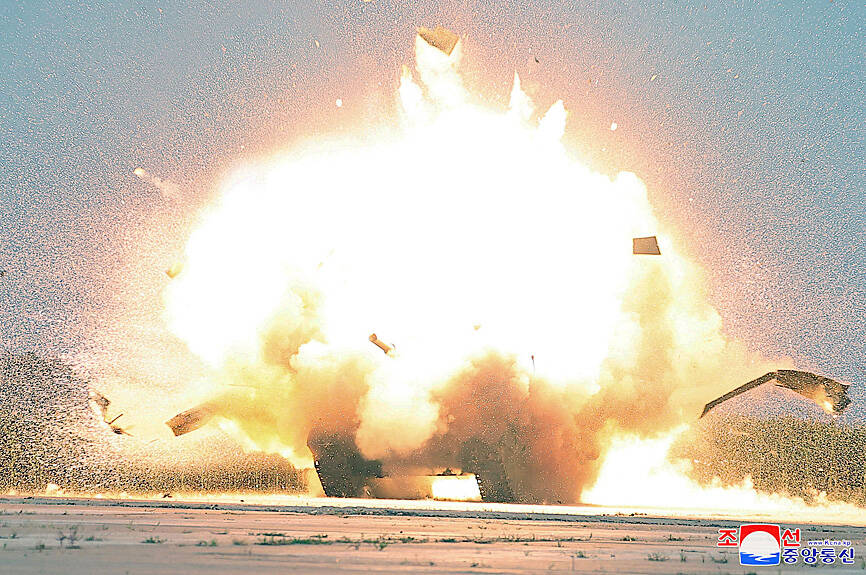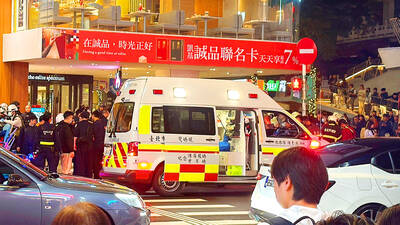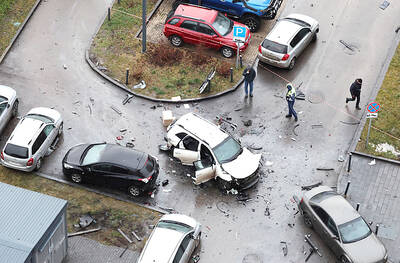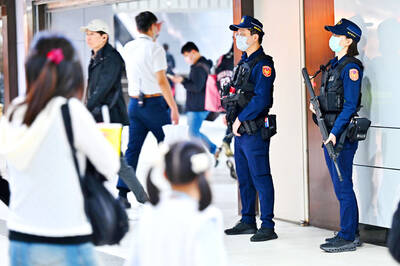North Korean leader Kim Jong-un supervised a demonstration of new exploding drones designed to crash into targets, state media said yesterday, as the US and South Korea engaged in joint military drills.
North Korean test photographs showed a white drone with X-shaped tails and wings supposedly crashing into and destroying a target resembling South Korea’s main K-2 battle tank. Most combat drones stand off from targets and fire missiles.
North Korea’s Korean Central News Agency (KCNA) said that Saturday’s test involved various types of drones built to fly different ranges to attack enemy targets on land and sea, and flew along various routes before accurately hitting test targets.

Photo: AFP / KCNA VIA KNS
After the test, Kim pledged to spur the development of drones that explode on impact, conduct reconnaissance or attack targets underwater to boost his nation’s war readiness, adding that North Korea’s military should be equipped with advanced drones “as early as possible,” KCNA said.
The drone test came as the US and South Korean militaries conduct large-scale Ulchi Freedom Shield drills, which continue until Thursday. The exercises focus on enhancing their readiness against North Korean threats, and include computer-simulated war games and live-fire training, with a combined aerial drill involving 60 warplanes that began yesterday.
South Korea’s air force said the drill, which began with precision-bombing demonstrations that included South Korean F-35 and F-16 jets, is aimed at coping with North Korean threats posed by drones, cruise missiles and artillery.
The US and South Korea yesterday also began a separate amphibious landing drill involving dozens of aircraft and vessels from their navies and marines, including US F-35 jets and amphibious assault ship the USS Boxer.
South Korea’s military said that the Ssangyong Exercise, which is to continue through Sept. 7, is aimed at sharpening combat interoperability.
Lee Chang-hyun, spokesperson of South Korea’s Joint Chiefs of Staff, said during a briefing that South Korea’s military was closely examining North Korea’s drone capabilities and that the South Korean military is equipped with systems to detect and intercept them, without providing further details.
Some analysts said that the North Korean drones shown in state media resembled Russia’s Zala Lancet-3 drones, and Lee said that South Korea was looking into the possibility that Russia had helped North Korea acquire its drone capability.
“We are aware that during the past exchanges between North Korea and Russia that some [drones] were given [to North Korea] as gifts,” Lee said. “We would need to analyze various aspects, including whether [North Korea] would have modified to improve their capabilities or other possibilities.”
North Korea and Russia have been aligning closely in the face of their separate confrontations with the US. Kim and Russian President Vladimir Putin held summits in June and in September last year.
Washington and its allies have accused the nations of expanding an alleged arms arrangement in which North Korea provides Putin with badly needed munitions to prolong Russia’s fighting in Ukraine in exchange for economic aid and technologies to upgrade Kim’s nuclear-armed military.

TRAGEDY STRIKES TAIPEI: The suspect died after falling off a building after he threw smoke grenades into Taipei Main Station and went on a killing spree in Zhongshan A 27-year-old suspect allegedly threw smoke grenades in Taipei Main Station and then proceeded to Zhongshan MRT Station in a random killing spree that resulted in the death of the suspect and two other civilians, and seven injured, including one in critical condition, as of press time last night. The suspect, identified as a man surnamed Chang Wen (張文), allegedly began the attack at Taipei Main Station, the Taipei Fire Department said, adding that it received a report at 5:24pm that smoke grenades had been thrown in the station. One man in his 50s was rushed to hospital after a cardiac arrest

A car bomb killed a senior Russian general in southern Moscow yesterday morning, the latest high-profile army figure to be blown up in a blast that came just hours after Russian and Ukrainian delegates held separate talks in Miami on a plan to end the war. Kyiv has not commented on the incident, but Russian investigators said they were probing whether the blast was “linked” to “Ukrainian special forces.” The attack was similar to other assassinations of generals and pro-war figures that have either been claimed, or are widely believed to have been orchestrated, by Ukraine. Russian Lieutenant General Fanil Sarvarov, 56, head

SAFETY FIRST: Double the number of police were deployed at the Taipei Marathon, while other cities released plans to bolster public event safety Authorities across Taiwan have stepped up security measures ahead of Christmas and New Year events, following a knife and smoke bomb attack in Taipei on Friday that left four people dead and 11 injured. In a bid to prevent potential copycat incidents, police deployments have been expanded for large gatherings, transport hubs, and other crowded public spaces, according to official statements from police and city authorities. Taipei Mayor Chiang Wan-an (蔣萬安) said the city has “comprehensively raised security readiness” in crowded areas, increased police deployments with armed officers, and intensified patrols during weekends and nighttime hours. For large-scale events, security checkpoints and explosives

PUBLIC SAFETY: The premier said that security would be tightened in transport hubs, while President Lai commended the public for their bravery The government is to deploy more police, including rapid response units, in crowded public areas to ensure a swift response to any threats, President William Lai (賴清德) said yesterday after a knife attack killed three people and injured 11 in Taipei the previous day. Lai made the remarks following a briefing by the National Police Agency on the progress of the investigation, saying that the attack underscored the importance of cooperation in public security between the central and local governments. The attack unfolded in the early evening on Friday around Taipei Main Station’s M7 exit and later near the Taipei MRT’s Zhongshan